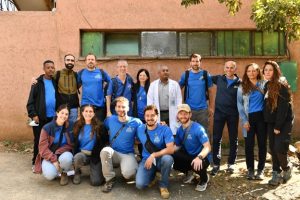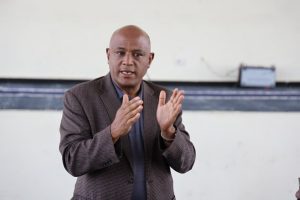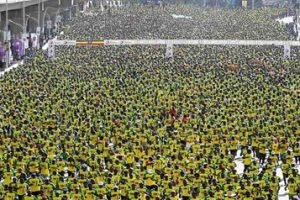
It is an interesting story about Anna Getaneh written by her. It narrates her success, ups and downs to share her remarkable experience to esteemed readers.
Anna was born in Stockholm, Sweden to Ethiopian parents. She grew up in Sweden, Liberia, Belgium, Ethiopia, France, USA and South Africa. Growing up, she disliked her name and wanted an Ethiopian name like her siblings, until she understood the story behind her naming. She was named after a nurse who saw to her delivery and helped her mom through a very difficult labor.
Growing up, she became a creative, playful, adaptive young girl. Her father, a career Diplomat, had always been a patriotic Pan-African who used to teach people about Ethiopia’s rich culture and history, whereas, the media she was exposed to use to only focus on Ethiopia’s drought and poverty.
Whenever she asked her father about the contradiction, he would tell her it was up to her to tell her story and change the perception. Her mother was also a very creative person who would always make and wear Ethiopian clothing during occasions and cook Ethiopian meals weekends and cultural days of our schools.
She grew up knowing and appreciating her fascinating culture and Ethiopian heritage. She recalled “I took a train to Paris one weekend without telling my parents and walked into one of the best agencies and told them I wanted to be a model.”
Throughout her teens, she was not certain about what she wanted to be and do in life, although she had the sense that it would be around the creative. Although she was told that she wouldn’t make any money in the creative industry, she knew that she did not want to take up the standard professional fields that most young people were advised to take up.
She later went on to study Business and Marketing.While in college many people encouraged her to go into modeling. Through a modeling agency in Brussels, she began to do a few modeling gigs which paved the way for her entry into the Paris modeling scene.
She believes she just happened to be at the right place, at the right time, as there was a demand for black women in the industry then in the 1990s. With Paris as her main market, she also worked in many other cities. She remembers an encounter when she was in London with a French international charity organization, Pharmacists without Borders that wanted to do a fundraiser for refugees in East Africa.
When they contacted her through her agency and told her they wanted to create awareness of the refugee issues in East Africa, she told them that she did not want to do an event showing dying children and rather wanted to experiment with something creative and different.
Thinking of art, she contacted five renowned Ethiopian artists, including Skunder Bogosian, Yohannis Ghedamu and Tesfaye Tessema who were brought onboard for the fundraiser which managed raise the money to buy medicines for Ethiopian, Somali and Kenyan refugees in Moyale, Kenya.
She then travelled with the team delivering the medicine to Moyale for a week and volunteered to participate in the feeding program. What she saw there was the turning point for her. In that moment, it became very clear what she want to do with her life.Upon her return to Paris, she launched Ethiopian Children’s Fund (ECF).
Returning shortly to Ethiopia, she visited orphanages in Addis Ababa and identified three organizations to work with – School for the Blind, Sisters of Charity and Abebech Gobena. Her initial approach was to continue utilizing the arts as a fundraising mechanism, but she soon realized that raising money and donating it was not the work she wanted to do.
Desiring to be more involved, she registered her own NGO in Ethiopia and started the work towards building a school in the village of Aleltu, bordering Oromia and Amhara states. The village only had 15,000 inhabitants with a small elementary school, but no clinic, high school or other infrastructure at the time. Her consultation with community stakeholders also established the need for a school, and hence the two-year journey for acquiring land and building the school would ensue.
Now, 16 years later, ECF is the only one operational in that village and has grown to supporting over 900 students providing primary education up to the eighth grade, with an equal distribution of female and male students. In addition to the formal education, she has extracurricular activities such as girls’ soccer team, and clubs like photography, art, poetry, dance, music. She has various activities to keep them in school because they do not study when they go home as they get busy with household chores.
One of the worries for ECF was transitioning students into high school in a village that had not had any other schools. However, the year the first cohort of eight graders finished their education, a government high school was operational, making the transition for further education smoother.
“We wanted them to experience the real world outside of our organization. So the opening of the high school couldn’t have come at a better time. We still buy their school materials, uniforms, meals and use our clinics while they’re attending 9th and 10th grades. ” she said
Modeling opened doors for her charity work. Fundraising for ECF in the initial stages entailed utilizing her own funds and that collected from family and friends. However, she soon found out that would not be a sustainable approach and began organizing fashion shows as a means to raise funds.
With her love of culture and particularly African art, the first show comprised African designs, and she named it African Mosaique. In its inception, a one of event, African Mosaique mobilized 50 models, makeup artists, 20 designers from 20 different African countries, for a show at the end of Paris Fashion Week.
Although her expectations were high, thinking she would raise enough to build 5 schools, what she managed to raise was just enough to build the first phase of the first school. Her friends said “we’re going to go on the road until you raise the money you need”. So, we did 8 shows in 10 cities before we came to Addis: New York (twice), Washington DC (twice), Chicago, Atlanta, and back to Paris. With the funds raised, we built the school, hired teachers and we had it up and running.
With that track record at hand, she started going through the normal procedure of writing proposals to raise money. African Mosaique just became this wonderful thing and the number one priority in her life. She enjoyed meeting the designers and working with them in their countries. In the last 15 years, she travelled to 30 African countries. She decided to stop modeling to focus on African Mosaique, explore and develop a business model that’s sustainable and successful to support ECF.
When her husband was offered a job in South Africa, she was happy because it allowed her to work in Africa, studying the African fashion industry. Thereafter, she started the for-profit arm of African Mosaique. However, her dream has always been to return to Ethiopia but she did not know how she could make that happen in her modeling years.
Even after she established ECF, she was coming to Ethiopia few times a year but still didn’t see how it would fit with her life. When her husband was based in Nairobi, he said “I know you always want to return to Ethiopia and I’m not going to ask you to come and settle in Nairobi, so close to Addis. I can’t ask you to do that so I’ll come on weekends”. She moved to Ethiopia with her kids with her husband visiting as often as possible.
She is happy now that she is in Ethiopia, running her school and working on opening more schools with the same holistic model in remote villages. With a lean budget, she managed to create a wonderful community. Her students start in grade one and continue until grade 8.
She has no more than 40 students in each class but due to dropouts, they are about 25 in grade 8. In the past 17 years, we have had 900 kids who have been educated in our school. The kids who joined us when they were 4 and 5 are now 20 and 21, and have joined university. Between 10 to 15 students are graduating from universities annually.
Her latest venture is expanding the African Mosaique collection. She is building a center with space for creativity, design, production and manufacturing. She creates a space for young talents and designers to come and collaborate. It will also be a space for mentoring, coaching and transfer of knowledge.
Apart from the school, she is consolidating everything that she is involved in into one place. She is launching the center in October 2017 and she will continue to hold African Mosaique fashion shows.
The Ethiopian Herald Sunday Edition 15 September 2019
BY MEHARI BEYENE





